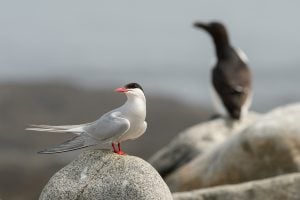
Wildlife
The otter, the urchin and the Haida
As the sea otter begins its long-overdue return to Haida Gwaii, careful plans are being laid to welcome them — and to preserve a prosperous shellfish harvest
- 3015 words
- 13 minutes
This article is over 5 years old and may contain outdated information.
Wildlife

The only sneezes people would expect from a sponge would be on SpongeBob SquarePants.
But a new study has found that sea sponges possess the very human-like ability to sneeze.
After exposing a sea sponge to a controlled amount of the drug Glutamate, which acts as a stimulus to the nervous system, a University of Alberta research team was able to get the sea sponge to exhibit what looks like a sneeze.
Although the sea sponge does not having a brain or sensory cells, the research findings suggest it may still be conscious of its surroundings.
“We now have a handle on the fact that the sponge is aware of its environment,” says Sally Leys, the chief supervisor of the study. “If we know that sea sponges are sensitive and respond in this fashion, then we have a tool to understand what is normal and what aspects in the environment are changing and causing them to do this.”
Master student Danielle Ludeman, who is working on the study, says the sea sponge’s “sneeze” is similar to a human sneeze, only the sponge uses water instead of air. “The response is a way that they can effectively flush out things from their bodies that they don’t want,” she says.
Another method the research team uncovered to achieve the sneeze was to vigorously shake the sponge. “The movement of the water causes the cells to be sensitized,” Leys says, adding this is similar to humans, who also sneeze when they come into contact with irritants. And just like humans, sponges display agitated behaviour before releasing their sneeze.
“When the water comes out, the sponge jitters,” says Leys. “There tends to be a buildup of tension, followed by this full-blown wringing out or contraction that flushes the system.” As a result, the sponge shrinks down to one-third of its size and then uses water to wash irritants away.
To see how a sea sponge sneezes, watch the video below from Leys and Ludeman.
Are you passionate about Canadian geography?
You can support Canadian Geographic in 3 ways:

Wildlife
As the sea otter begins its long-overdue return to Haida Gwaii, careful plans are being laid to welcome them — and to preserve a prosperous shellfish harvest

Environment
Two marine biologists offer a glimpse of life at the bottom of the ocean during 2018, 2019 and 2020 seamount expeditions

Wildlife
An estimated annual $175-billion business, the illegal trade in wildlife is the world’s fourth-largest criminal enterprise. It stands to radically alter the animal kingdom.

Wildlife
On New Brunswick’s Machias Seal Island, predatory gulls are pushing endangered Arctic tern colonies to the brink, creating a dilemma for wildlife managers